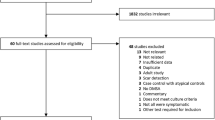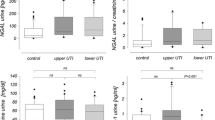Abstract
Background
This study aimed to test the hypothesis that reduced urinary excretions of neutrophil gelatinase-associated lipocalin (NGAL) predispose children to recurrence of febrile urinary tract infection (fUTI).
Methods
Subjects were 38 children diagnosed with fUTI. To examine risk factors for recurrence of fUTI, the subjects were divided into a non-recurrent group and a recurrent group according to the presence or absence of fUTI over 3 years since the first episode. We measured the urinary NGAL levels in patients with fUTI at the non-infected stage in addition to age-matched healthy control children.
Results
In a multiple logistic regression analysis, significant differences between the groups were not observed for age, sex, the prevalence of kidney scarring and bladder bowel dysfunction, urinary β2-microglobulin/creatinine (Cr) level, and serum levels of Cr and Cystatin C, while the recurrent group had significantly more cases with grade III or higher vesicoureteral reflux (p < 0.01). Furthermore, the urinary NGAL/Cr in the recurrent group (median, 3.60 μg/gCr) was significantly lower than that in the non-recurrent group (median, 16.47 μg/gCr; p < 0.01), and age-matched healthy control children (median, 14.14 μg/gCr; p < 0.05). The area under the receiver operating characteristic curve of NGAL/Cr was 0.86 for predicting recurrence of fUTI. A cut-off value of 11.59 μg/gCr had the best accuracy to predict recurrent fUTI yielding a specificity of 78% and a sensitivity of 93%.
Conclusions
Reduced levels of urinary NGAL, which protects against urinary infection, are a risk factor for recurrence of fUTI and could serve as a biomarker.



Similar content being viewed by others
References
Chesney RW, Carpenter MA, Moxey-Mims M, Nyberg L, Greenfield SP, Hoberman A, Keren R, Matthews R, Matoo TK, members of the RIVUR Steering Committee (2008) Randomized intervention for children with vesicoureteral reflux (RIVUR): background commentary of RIVUR investigators. Pediatrics 122:S233–S239
Hellström A, Hanson E, Hansson S, Hjälmås K, Jodal U (1991) Association between urinary symptoms at 7 years old and previous urinary tract infection. Arch Dis Child 66:232–234
Finnell SM, Carroll AE, Downs SM, Subcommittee on Urinary Tract Infection (2011) Technical report-diagnosis and management of an initial UTI in febrile infants and young children. Pediatrics 128:e749–e770
Stein R, Dogan HS, Hoebeke P, Kočvara R, RJM N, Radmayr C, Tekgül S, European Association of Urology; European Society for Pediatric Urology (2015) Urinary tract infections in children: EAU/ESPU guidelines. Eur Urol 67:546–558
Matoo TK (2011) Vesioureteral reflux and reflux nephropathy. Adv Chronic Kidney Dis 18:348–354
Mishra J, Dent C, Tarabishi R, Mitsnefes MM, Ma Q, Kelly C, Ruff SM, Zahedi K, Shao M, Bean J, Mori K, Barasch J, Devarajan P (2005) Neutrophil gelatinase-associated lipocalin (NGAL) as a biomarker for acute renal injury after cardiac surgery. Lancet 365:1231–1238
Wagener G, Jan M, Kim M, Mori K, Barasch JM, Sladen RN, Lee HT (2006) Association between increases in urinary neutrophil gelatinase-associated lipocalin and acute renal dysfunction after adult cardiac surgery. Anesthesiology 105:485–491
Flo TH, Smith KD, Sato S, Rodriguez DJ, Holmes MA, Strong RK, Akira S, Aderem A (2004) Lipocalin 2 mediates an innate immune response to bacterial infection by sequestrating iron. Nature 432:917–921
Chan YR, Liu JS, Pociask DA, Zheng M, Mietzner TA, Berger T, Mak TW, Clifton MC, Strong RK, Ray P, Kolls JK (2009) Lipocalin 2 is required for pulmonary host defense against Klebsiella infection. J Immunol 182:4947–4956
Rushton HG, Majd M, Chandra R, Yim D (1988) Evaluation of 99mtechnetium-dimercapto-succinic acid renal scans in experimental acute pyelonephritis in piglets. J Urol 140:1169–1174
Abbasi A, Nabizadeh F, Gardeh M, Ali KM, Yousefifard M, Hosseini M (2020) Discriminatory precision of neutrophil gelatinase-associated lipocalin in detection of urinary tract infection in children: a systematic review and meta-analysis. Arch Acad Emerg Med 8:e56
McWilliam SJ, Antoine DJ, Sabbisetti V, Pearce RE, Jorgensen AL, Lin Y, Leeder JS, Bonventre JV, Smyth RL, Pirmohamed M (2014) Reference intervals for urinary renal injury biomarkers KIM-1 and NGAL in healthy children. Biomark Med 8:1189–1197
Parikh CR, Butrymowicz I, Yu A, Chinchilli VM, Park M, Hsu CY, Reeves WB, Devarajan P, Kimmel PL, Siew ED, Liu KD, ASSESS-AKI Study Investigators (2014) Urine stability studies for novel biomarkers of acute kidney injury. Am J Kidney Dis 63:567–572
Forster CS, Johnson K, Patel V, Wax R, Rodig N, Barasch J, Bachur R, Lee RS (2017) Urinary NGAL deficiency in recurrent urinary tract infections. Pediatr Nephrol 32:1077–1080
Bennett MR, Nehus E, Haffner C, Ma Q, Devarajan P (2015) Pediatric reference ranges for acute kidney injury biomarkers. Pediatr Nephrol 30:677–685
Parmaksız G, Noyan A, Dursun H, İnce E, Anarat R, Cengiz N (2016) Role of new biomarkers for predicting renal scarring in vesicoureteral reflux: NGAL, KIM-1, and L-FABP. Pediatr Nephrol 31:97–103
Mori K, Lee HT, Rapoport D, Drexler IR, Foster K, Yang J, Schmidt-Ott KM, Chen X, Li JY, Weiss S, Mishra J, Cheema FH, Markowitz G, Suganami T, Sawai K, Mukoyama M, Kunis C, D’Agati V, Devarajan P, Barasch J (2005) Endocytic delivery of lipocalin-siderophore-iron complex rescues the kidney from ischemia-reperfusion injury. J Clin Invest 115:610–621
Kanda J, Mori K, Kawabata H, Kuwabara T, Mori KP, Imamaki H, Kasahara M, Yokoi H, Mizumoto C, Thoennissen NH, Koeffler HP, Barasch J, Takaori-Kondo A, Mukoyama M, Nakao K (2015) An AKI biomarker lipocalin 2 in the blood derives from the kidney in renal injury but from neutrophils in normal and infected conditions. Clin Exp Nephrol 19:99–106
Mori KP, Yokoi H, Kasahara M, Imamaki H, Ishii A, Kuwabara T, Koga K, Kato Y, Toda N, Ohno S, Kuwahara K, Endo T, Nakao K, Yanagita M, Mukoyama M, Mori K (2017) Increase of total nephron albumin filtration and reabsorption in diabetic nephropathy. J Am Soc Nephrol 28:278–289
Imamaki H, Ishii A, Yokoi H, Kasahara M, Kuwabara T, Mori KP, Kato Y, Kuwahara T, Satoh M, Nakatani K, Saito Y, Tomosugi N, Sugawara A, Nakao K, Mukoyama M, Yanagita M, Mori K (2015) Low serum neutrophil gelatinase-associated lipocalin level as a marker of malnutrition in maintenance hemodialysis patients. PLoS One 10:e0132539
Paragas N, Kulkarni R, Werth M, Schmidt-Ott KM, Forster C, Deng R, Zhang Q, Singer E, Klose AD, Shen TH, Francis KP, Ray S, Vijayakumar S, Seward S, Bovino ME, Xu K, Takabe Y, Amaral FE, Mohan S, Wax R, Corbin K, Sanna-Cherchi S, Mori K, Johnson L, Nickolas T, D’Agati V, Lin CS, Qiu A, Al-Awqati Q, Ratner AJ, Barasch J (2014)α-Intercalated cells defend the urinary system from bacterial infection. J Clin Invest 124:2963–2976
Barasch J, Mori K (2004) Cell biology: iron thievery. Nature 432:811–813
Jordan A, Reichard P (1998) Ribonucleotide reductases. Annu Rev Biochem 67:71–98
Spencer JD, Schwaderer AL, Becknell B, Watson J, Hains DS (2014) The innate immune response during urinary tract infection and pyelonephritis. Pediatr Nephrol 29:1139–1149
Xiao X, Yeoh BS, Vijay-Kumar M (2017) Lipocalin 2: an emerging player in iron homeostasis and inflammation. Annu Rev Nutr 37:103–130
Karoly E, Fekete A, Banki NF, Szebeni B, Vannay A, Szabo AJ, Tulassay T, Reusz GS (2007) Heat shock protein 72 (HSPA1B) gene polymorphism and Toll-like receptor (TLR) 4 mutation are associated with increased risk of urinary tract infection in children. Pediatr Res 61:371–374
Cai L, Rubin J, Han W, Venge P, Xu S (2010) The origin of multiple molecular forms in urine of HNL/NGAL. Clin J Am Soc Nephrol 5:2229–2235
Nickolas TL, Forster CS, Sise ME, Barasch N, Solá-Del Valle D, Viltard M, Buchen C, Kupferman S, Carnevali ML, Bennett M, Mattei S, Bovino A, Argentiero L, Magnano A, Devarajan P, Mori K, Erdjument-Bromage H, Tempst P, Allegri L, Barasch J (2012) NGAL (Lcn2) monomer is associated with tubulointerstitial damage in chronic kidney disease. Kidney Int 82:718–722
Helmersson-Karlqvist J, Arnlöv J, Larsson A (2013)Day-to-day variation of urinary NGAL and rational for creatinine correction. Clin Biochem 46:70–72
Sadeghi-Bojd S, Naghshizadian R, Mazaheri M, Ghane Sharbaf F, Assadi F (2020) Efficacy of probiotic prophylaxis after the first febrile urinary tract infection in children with normal urinary tracts. J Pediatric Infect Dis Soc 9:305–310
Acknowledgments
We thank Edanz Group (https://en-author-services.edanzgroup.com/ac) for editing a draft of this manuscript.
Author information
Authors and Affiliations
Corresponding author
Ethics declarations
Conflict of interest
The authors declare that they have no conflict of interest.
Ethics approval and consent to participate
This study was performed with the approval of the Kansai Medical University ethics committee (no. 1518) in accordance with the principles of the Declaration of Helsinki. This article does not contain any studies with animals performed by any of the authors. Informed consent was obtained from the parents of all individual participants included in the study.
Additional information
Publisher’s note
Springer Nature remains neutral with regard to jurisdictional claims in published maps and institutional affiliations.
Rights and permissions
About this article
Cite this article
Yamanouchi, S., Kimata, T., Akagawa, Y. et al. Reduced urinary excretion of neutrophil gelatinase-associated lipocalin as a risk factor for recurrence of febrile urinary tract infection in children. Pediatr Nephrol 36, 1473–1479 (2021). https://doi.org/10.1007/s00467-020-04863-2
Received:
Revised:
Accepted:
Published:
Issue Date:
DOI: https://doi.org/10.1007/s00467-020-04863-2




